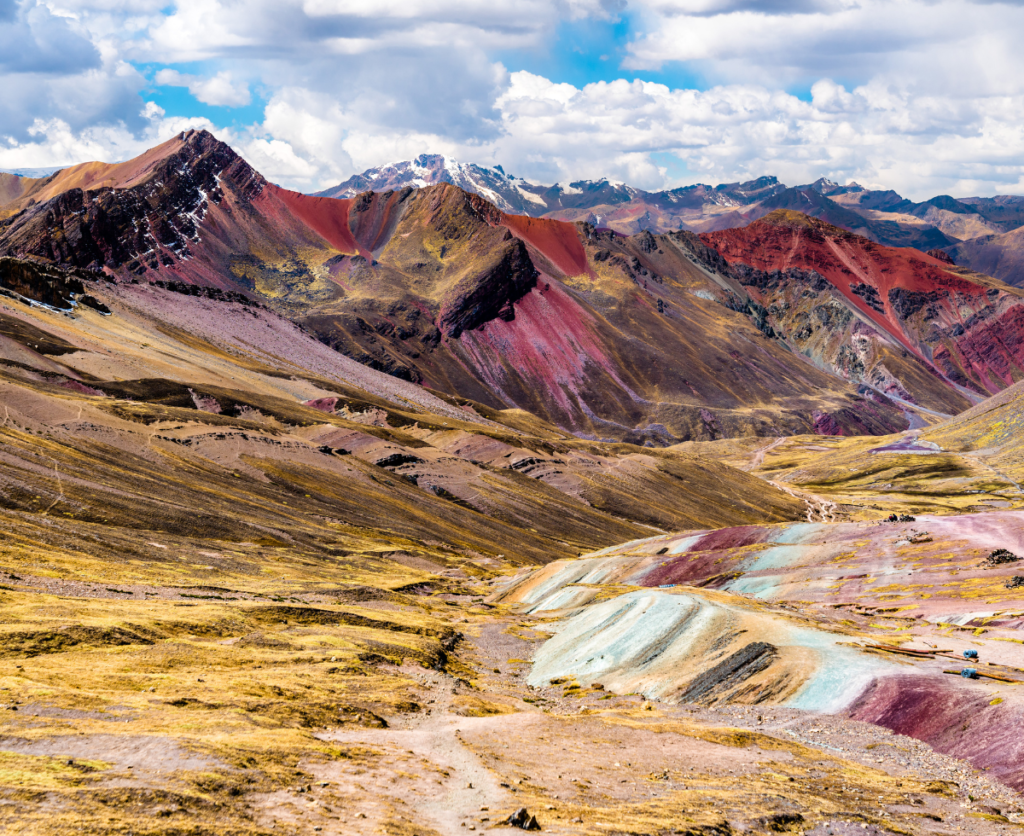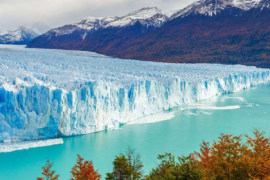Mysteries of the Mountain of the 7 Colors. Welcome to the enchanting world of the Mountain of the 7 Colors.
Where nature’s palette comes alive in a breathtaking display of vibrant hues. Nestled in the heart of the Andes, this geological wonder has long captivated explorers and adventure seekers alike. From its striking reds and greens to its mesmerizing purples and blues.
This mountain is a testament to the incredible forces that have shaped our planet over millions of years. In this comprehensive guide, we will peel back the layers and unveil the mysteries of this awe-inspiring natural phenomenon.

Formation and geological composition of the Mountain
The Mountain of the 7 Colors, also known as Vinicunca or Rainbow Mountain.
It is located in the Cusco region of Peru.
Standing at an impressive altitude of approximately 5,200 meters (17,060 feet) above sea level. The mountain is part of the Andes.
The longest mountain range in the world, which stretches across several countries in South America.
The incredible colors that adorn the mountain are a result of different mineral deposits within these rock formations. Iron oxide, which gives the mountain its vibrant red and orange hues, is particularly abundant in the area.
The geological forces that have shaped the Mountain of the 7 Colors are a fascinating combination of tectonic activity, weathering, and erosion. Over millions of years, the movement of tectonic plates has caused the Andes to rise, exposing the layers of rock that make up the mountain. Subsequent weathering and erosion by wind, water, and ice have gradually revealed the vibrant colors that lie beneath the surface. The result is a breathtaking spectacle that attracts visitors from all around the world.
Mysteries of the Mountain of the 7 Colors.
The unique colors of the Mountain and their origins
Iron-rich minerals present in the rock formations oxidize over time, giving rise to the vibrant red hues that dominate the landscape. The intensity of the red color can vary depending on the concentration of iron oxide in different areas of the mountain.
In addition to red, the Mountain of the 7 Colors boasts a kaleidoscope of other hues, including green, yellow, purple, and blue. The yellow color, on the other hand, is a result of sulfur deposits, which accumulate in the form of bright yellow patches on the surface.
Chlorite, a greenish mineral, can give rise to a purple color when it combines with iron oxide. Hematite, on the other hand, is an iron oxide mineral that can create a bluish tinge in certain sections of the mountain.
The combination of these various minerals and their interactions with light results in a mesmerizing display of colors that seem almost otherworldly. As the sunlight hits the mountain at different angles throughout the day, the colors appear to shift and change, creating a truly magical experience for those fortunate enough to witness it.Mysteries of the Mountain of the 7 Colors.
Exploring the biodiversity of the Mountain
While the Mountain of the 7 Colors is primarily known for its geological wonders, it is also home to a diverse range of flora and fauna. Despite the harsh conditions at such high altitudes, this mountain supports a surprising amount of life.
One of the most notable species found in the area is the Andean condor, a majestic bird with a wingspan of up to 3 meters (9.8 feet). These magnificent creatures are often spotted soaring above the mountain, their impressive size and graceful flight adding to the already awe-inspiring atmosphere. Other bird species, such as hummingbirds and eagles, can also be found in the region, providing a rich tapestry of avian life.
In terms of plant life, the Mountain of the 7 Colors boasts a variety of hardy species that have adapted to the harsh conditions. Mosses and lichens cling to the rocks, adding a splash of green to the otherwise barren landscape. Puya raimondii, also known as the Queen of the Andes, is another remarkable plant that can be found in the area. This giant bromeliad can reach heights of up to 12 meters (39 feet) and is known for its towering inflorescence of pink flowers.
The unique combination of geological features and biodiversity makes the Mountain of the 7 Colors a truly remarkable destination for nature lovers. Whether it’s witnessing the majestic flight of the condors or marveling at the resilience of the plant life, exploring the diverse ecosystems of this mountain is an unforgettable experience.
Mysteries of the Mountain of the 7 Colors.
Local myths and legends surrounding the Mountain
The Mountain of the 7 Colors holds a significant place in local mythology and is steeped in ancient legends. For the indigenous communities that have inhabited the region for centuries, the mountain is a sacred place, imbued with spiritual significance.
According to one legend, the colors of the mountain were created by the gods as a gift to the people. It is said that each color represents a different deity, and the vibrant hues are a reflection of the gods’ power and beauty. The mountain is considered a place of worship and pilgrimage, where offerings are made to honor the gods and seek their blessings.
Another belief held by the locals is that the mountain is a gateway to the spirit world. It is believed that the souls of the deceased pass through the mountain on their journey to the afterlife. As a result, the Mountain of the 7 Colors is considered a sacred burial ground, and visitors are encouraged to show respect and reverence when exploring its slopes.
These myths and legends add an air of mystique and spirituality to the already enchanting landscape of the Mountain of the 7 Colors. They serve as a reminder of the deep connections between nature and culture and highlight the importance of preserving and respecting this sacred place. Mysteries of the Mountain of the 7 Colors.
Ecotourism and sustainable practices at the Mountain
With the increasing popularity of the Mountain of the 7 Colors, it is crucial to ensure that tourism is managed in a sustainable and responsible manner.
To promote sustainable practices, local communities and tour operators have implemented various initiatives. One such initiative is the establishment of designated trails to minimize the impact on the sensitive vegetation and prevent erosion.
It is essential to respect these regulations and book tours with licensed operators to contribute to the preservation efforts.
Furthermore, the local communities have embraced ecotourism as a means of generating income while preserving their cultural heritage. Many tours offer opportunities to interact with the indigenous communities, providing a unique cultural experience for visitors. By supporting these community-based initiatives, tourists can contribute directly to the local economy and help sustain the traditional way of life.
Visiting the Mountain of the 7 Colors is not just about witnessing its breathtaking beauty; it is also an opportunity to be a responsible traveler and make a positive impact on the environment and local communities. By practicing sustainable tourism, we can ensure that this natural wonder remains intact for future generations to enjoy.
Tips for visiting the Mountain of the 7 Colors
Visiting the Mountain of the 7 Colors is a once-in-a-lifetime experience that requires careful planning and preparation. Here are some tips to help make your visit as enjoyable and memorable as possible:
- Acclimatize: Due to the high altitude, it is essential to spend a few days in Cusco or other high-altitude locations to acclimatize before attempting the trek to the mountain. This will help minimize the risk of altitude sickness and ensure a more comfortable experience.
- Dress appropriately: The weather at such high altitudes can be unpredictable, so it is crucial to dress in layers. Don’t forget to pack sunscreen and a hat to protect yourself from the strong UV rays.
- Stay hydrated: The combination of high altitude and physical exertion can lead to dehydration. Drink plenty of water throughout the trek to stay hydrated and prevent altitude-related symptoms.
- Take it slow: The trek to the Mountain of the 7 Colors can be physically demanding due to the altitude. Take your time and listen to your body. If you need to rest or catch your breath, don’t hesitate to do so.
- Capture the moment: The vibrant colors of the mountain make it a photographer’s paradise.
By following these tips, you can ensure a safe and enjoyable visit to the Mountain of the 7 Colors while also contributing to its preservation.
Photography and capturing the beauty of the Mountain
With its vibrant hues and stunning landscapes, it offers endless opportunities for capturing breathtaking images. Here are a few tips to help you make the most of your photography experience:
- Timing is everything: The lighting conditions at different times of the day can dramatically affect the appearance of the colors. Try to visit the mountain during the early morning or late afternoon when the sunlight is softer and casts long shadows, enhancing the depth and texture of the landscape.
- Composition matters: Look for interesting elements to include in your frame, such as rock formations, vegetation, or people interacting with the environment. Experiment with different angles and perspectives to create unique and compelling compositions.
- Play with colors: The mountain itself is a palette of colors.
- So don’t be afraid to experiment with different color combinations in your photographs. Look for contrasting colors or complementary hues that can create a visually striking image.
- Capture the details: While wide-angle shots can capture.
- The grandeur of the mountain, don’t forget to zoom in and capture the intricate details. Focus on the textures of the rocks.
- The patterns created by the different layers, or the delicate flowers that dot the landscape.
- Tell a story: Use your photographs to tell a story about your experience at the Mountain of the 7 Colors. Include images that showcase the local culture, the unique flora and fauna, or the interactions between people and the environment. By capturing these moments, you can create a more meaningful and personal narrative.
Remember, photography is not just about taking pictures; it is about capturing the essence and beauty of a place. Use your camera as a tool to convey your emotions and share your experience with others.
Other geological wonders in the surrounding area
The Mountain of the 7 Colors is not the only geological wonder in the region. The surrounding area is home to a diverse range of natural attractions that are worth exploring. Here are a few notable sites to consider:
- Ausangate Mountain: Located in the same region as the Mountain of the 7 Colors, Ausangate is the highest peak.
- Its snow-capped peak and rugged landscapes offer incredible opportunities for hiking and photography.
- Humantay Lake: Situated at the base of the Humantay Mountain, this turquoise-colored lake is a sight to behold. Surrounded by snow-capped peaks and lush vegetation, it offers a peaceful and serene setting for nature lovers and photographers.
- Exploring these terraces offers a glimpse into the advanced engineering and agricultural practices of the ancient Inca civilization.
- Maras Salt Mines: Located near the town of Maras, these salt mines have been in operation since Inca times. The salt pans, which are fed by a natural spring.
- Create a striking mosaic of white terraces that are both visually captivating and historically significant.
Exploring these sites will not only expand your understanding.
Of the geological processes at work but also provide a deeper appreciation for the natural beauty of the region.
Mysteries of the Mountain of the 7 Colors.
Conclusion
The Mountain of the 7 Colors is a testament to the incredible forces that have shaped our planet over millions of years. Its vibrant hues and stunning landscapes have captivated the hearts and minds of people from all walks of life. Through this comprehensive guide, we have peeled back the layers and unveiled the mysteries of this awe-inspiring natural phenomenon.
From the formation and geological composition of the mountain to the unique colors and their origins, we have explored the fascinating processes.
That have created this kaleidoscope of hues. We have delved into the biodiversity that thrives in this harsh environment.
And uncovered the local myths and legends that surround the mountain.
We have also emphasized the importance of practicing sustainable tourism and responsible photography to ensure.
The preservation of this natural wonder for future generations. By following the tips provided and respecting the rules and regulations, we can all contribute. Mysteries of the Mountain of the 7 Colors
Make your dream trip possible, receive a personalized quote and payment facilities to suit your needs
No compromises!





